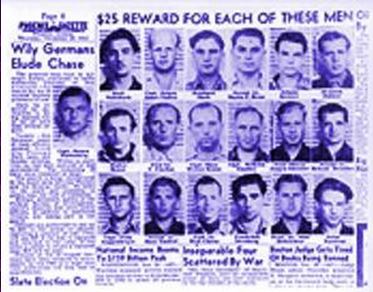Phoenix, Arizona
At the east edge of Phoenix and partly situated in adjacent Tempe, you will find Papago Park. The park is home to a zoo, a botanical garden, the final resting place of a longtime Arizona Governor, and the many typical amenities found in a city park. But this post is not about the park, at least not in the usual sense that I feature in my blog posts, anyway. This post is a digression from the norm and features a favorite subject of mine, history. In this case, World War II history…
With a tip of the hat to my blogger friend, G. P. Cox, my favorite WW II blogger, I shall attempt to describe what was to be the largest prisoner-of-war escape by German prisoners in World War II. You might ask what does this story have to do with Papago Park. In 1943, Camp Papago Park opened for business, first housing Italian and German prisoners, then becoming the exclusive home for the German submariners that were singled out to remain. Camp Papago Park would likely have been considered “Resort-style” accommodations by American prisoners of war in Germany, had they known what Camp Papago Park was like.
Photo credit: http://brazilbrazil.com/powcamp.html
Return with me to December 23, 70 years ago. A noisy “party” erupted in Compound 1B, acting as a diversion from the illicit activity in Compound 1A. Teams of two to three prisoners carrying civilian clothing, maps, and fake credentials crawled through a 178 foot tunnel that started at the bath house in a “blind spot” not visible from guard towers. Hidden by a large coal bin, the tunnel entrance was the start of a project would take around four months to complete.
Photo credit: http://www.azpbs.org/arizonastories/ppedetail.php?id=16
The plot line for the building of the tunnel and the escape could have been episodes of Hogan’s Heroes. Digging the tunnel required the hiding of large amounts of dirt. Besides flushing dirt down toilets and hiding it under barracks, the Germans requested, and received, permission to garden and to build a volleyball court. Both of these projects allowed prisoners to disguise large amounts of tunnel debris. The American guards were complacent on the possibility of prisoner tunneling because they believed the hard rock-like soil would discourage tunneling activities.
Photo credit: http://www.freerepublic.com/focus/news/2057765/posts?page=344
In all, 25 POWs made their escape that evening into the Phoenix metro area. It wasn’t until later Christmas Eve day that camp officials realized there had been an escape. Using stolen maps of the area, prisoners plotted to travel down local rivers to Mexico and then to German-friendly countries in South America. They even built collapsible boats that were tested by plugging the drains in the showers. In another plot twist worthy of Hogan’s Heroes, they found their main route out of Phoenix on the Salt River wouldn’t work because even though the map indicated blue where the river flows, The Salt River only flows during the summer monsoons. At Christmastime, 1944; the Salt River was nothing but a collection of puddles. The escapees ditched the boats and attempted to proceed on foot.
Eventually all prisoners were recaptured or turned themselves in and the (less than) Great Escape became a part of Arizona folklore.
References:
A complete accounting of the escapade can be found here: http://www.historynet.com/the-not-so-great-escape-german-pows-in-the-us-during-wwii.htm
AZPBS, featured a program on the escape, a transcript featuring a Phoenix area reporter who researched and reported on the escape in a 10th anniversary story can be found here: http://www.azpbs.org/arizonastories/seasontwo/greatescape.htm
A play called “Flight from Phoenix” focused on the story. An article containing a detailed recounting of the plot and its story is featured here: http://www.phoenixnewtimes.com/2001-03-08/news/flight-from-phoenix/full/
You can read more World War II history in the Pacific theater from G. P. Cox at his blog here: https://pacificparatrooper.wordpress.com/tag/paratroopers/
John Steiner




